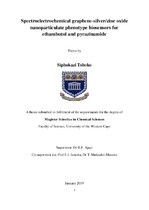| dc.description.abstract | Tuberculosis (TB), a deadly disease second to HIV/AIDS, is a global health problem.
Diagnosis of active tuberculosis is tedious and requires expensive procedures since there is
no recognizable method for sole detection of active TB. Although this is a deadly disease,
treatment drug toxicity is also an issue that also causes fatalities in diagnosed patients.
Therefore, a rapid sensitive and specific diagnostic method is imperative for TB drug
management. In this study spectroscopic and/or electrochemical biosensors were developed
for the detection and quantification of TB treatment drugs. The biosensors were constructed
with electroactive layers of graphene oxide coupled to silver nanoparticles and/or zinc oxide
nanoparticles. These nanoparticles coupled with graphene oxide sheets were covalently
attached onto the enzymes such as Cytochrome P450-2D6 to achieve the electrochemical
detection of the TB treatment drugs and obtain the required electron transfer between the
electrode surface and enzyme. The surface morphology of graphene oxide, nanoparticles as
well as the green synthesized nanocomposites were achieved using High-Resolution
Transmission Electron Microscopy (HRTEM), Atomic Force Microscopy (AFM), and High-
Resolution Scanning Electron Microscopy (HRSEM) while the elemental analysis were
obtained using Fourier Transform Infrared Spectroscopy (FTIR), Energy Dispersive X-Ray
(EDX), Raman spectroscopy and X-Ray diffraction (XRD). Additionally, the optical
properties of the developed nanocomposites where further characterised using Small Angle
X-ray Scattering (SAXS), Photoluminescence Spectroscopy (PL) and Ultraviolet
Spectroscopy (UV-vis). The electrochemical studies were obtained using cyclic voltammetry
(CV) and showed an increase in electron conductivity for the green synthesized zinc oxide
nanoparticles coupled with graphene oxide (ZnONPs/GO) and silver nanoparticles coupled
with graphene oxide (AgNPs/GO) nanocomposite which was an indication that they were suitable as platforms towards biosensor development. Furthermore, amperometric technique
was also used for biotransformation of the TB treatment drugs (Ethambutol and
Pyrazinamide) in standard solutions of 0.1 M phosphate buffer (pH 7.0). Furthermore, the
sensitivity value of 0.0748 μA/μM was determined for the ethambutol biosensor while a
value of 0.1715 μA/μM was determined for the pyrazinamide biosensors. Very good
detection limits were obtained for the standard solutions of ethambutol and pyrazinamide
where a value of 0.02057 nM was determined for ethambutol at concentration linear range of
50 μM – 400 μM. Additionally, a value of 0.8975 x 10-2 nM was determined for
pyrazinamide at the concentration linear range of 100 μM – 300 μM. The determined limit of
detections have provided a clear indication that these biosensors have potential of being used
in human samples since these values are below the peak serum concentrations of these drugs
in TB diagnosed patients as reported in literature. This was further confirmed by the limit of
quantification values determined for each biosensor where a value of 0.8975 x 10-2 nM was
determined for pyrazinamide and a value of 0.02057 nM was determined for ethambutol. | en_US |

